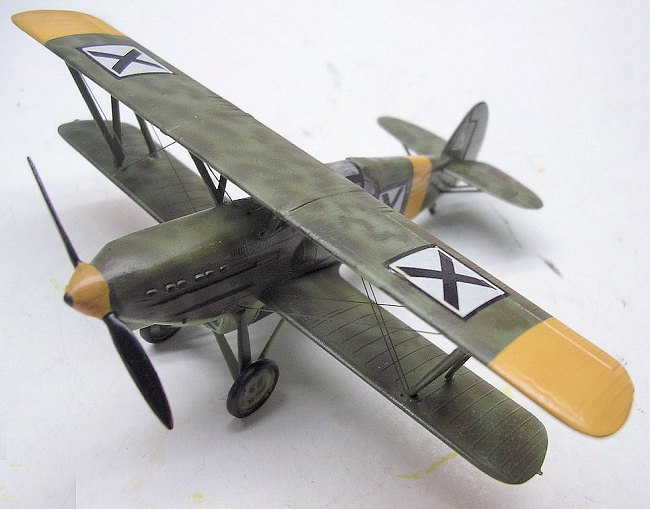
KP 1/72 Avia B.534
| KIT #: | ? |
| PRICE: | Currently offered at $6.95 |
| DECALS: | Two options |
| REVIEWER: | Carmel J. Attard |
| NOTES: | Injection molded |

| HISTORY |
The Avia B534 was the most important aircraft built in Czechoslovakia before WWII. It is a biplane with fixed landing gear and had a closed cockpit. Entering service with the Czech AF in 1934, while others went to Greece and Yugoslavia. Although obsolete by 1939 it was in service with German, Slovak and Bulgarian AF. Three Avias were utilized for trials on board the never completed German aircraft carrier Graf Zeppelin II. The Avia 534 carried machine guns mounted between cylinder banks allowing easy firing through propeller hubs. The performance of the Avia was surprisingly impressive for bi-planes and in 1937 at the International Air Meeting in Zurich these aircraft came second in team races only to the Bf-109 German fighter whose average speeds were hardly 7 mph faster.
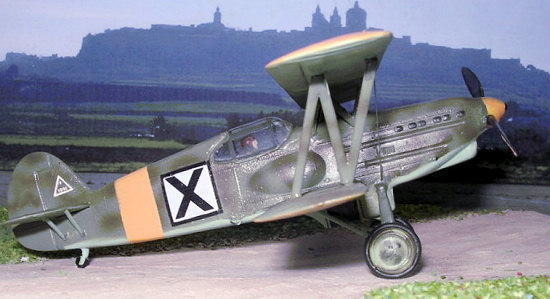 The
following historical events describe the Avia B-534 while in service with the
Bulgarian Air Force when they were allies with the Germans during World War
Two. Even though it was rendered as an obsolete Czech machine the Avia B-534
formed the greater part of the Bulgarian fighter force around 1940. It remained
so until more modern aircraft arrived in autumn of 1943 just after the invasion
of Italy.
The
following historical events describe the Avia B-534 while in service with the
Bulgarian Air Force when they were allies with the Germans during World War
Two. Even though it was rendered as an obsolete Czech machine the Avia B-534
formed the greater part of the Bulgarian fighter force around 1940. It remained
so until more modern aircraft arrived in autumn of 1943 just after the invasion
of Italy.
In main Bulgarian bases like Korlovo, Bojourishte, Asen, and Vrajdebna airfields there were no less than 124 aircraft distributed on these bases. These formed the 6th Orliak (regiment). However even though it was mid-1943 most of the aircraft, which were Avia B-534, were without radio or oxygen equipment installed in them. It so happened that during this crucial period of 1943, a second Ploesti raid was under way by the American bombers. The Bulgarians were warned early of the incoming B-24 Liberators by ground radar in Greece. The radar on Mount Vitosha tracked the 160 plus B-24 of Major General Louis Brerkton’s US 9th AAF as they entered Bulgarian territory on route to Ploesti on a raid called by the name “Tidal Wave”.
To the Bulgarians at first it appeared that the unescorted bombers were bound for Sofia. Both the 612th Eskadra and 622 Eskadra scrambled their Avia B-534s over Vrajdebna and Bojuristhe. In this process Lieutenant Rusi Rusev of 622 scrambled his force of Avias and rendezvoused with Lieutenant Martin Petrov’s 612 Squadron over the town of Berkouista, north of Sofia. Together they caught sight of the last box of B-24s that were heading for Romania. The Bulgarian B-534 were too slow to catch up with the bombers and even so they could not climb to combat height of 15,000 ft due to lack of oxygen equipment. To add to that the Americans seemed to have climbed to a higher level to clear the Bulgarian range of mountains comfortably. In view of these heights, the Avias gave up the chase and instead the leaders instructed their pilot’s intention to land, refuel in time in order to catch the American bombers on their return journey.
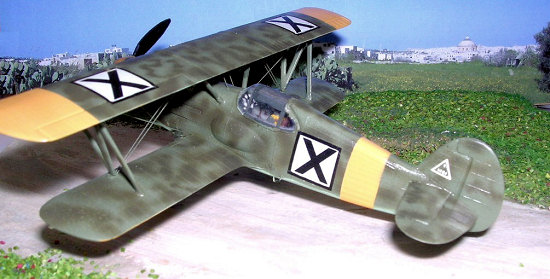 Of the
166 bombers that reached their target, others drifted away due to navigational
errors, 50 others were also lost mainly to accurate Luftwaffe flak and
falling prey to strong German and Romanian fighters, vectored to the scene by
Luftwaffe in control of the Balkan sector. The remaining American bomber force
were scattered over an area of the sky following a brief withdrawal route across
Western Bulgaria. There was a wild confusion over the oil refineries and it was
the chance for the Avia B-534 to take advantage of the evolving situation.
Of the
166 bombers that reached their target, others drifted away due to navigational
errors, 50 others were also lost mainly to accurate Luftwaffe flak and
falling prey to strong German and Romanian fighters, vectored to the scene by
Luftwaffe in control of the Balkan sector. The remaining American bomber force
were scattered over an area of the sky following a brief withdrawal route across
Western Bulgaria. There was a wild confusion over the oil refineries and it was
the chance for the Avia B-534 to take advantage of the evolving situation.
Two formations of 534s patrolled the 6,500 ft Ossogovaska Planina range thus blocking the way forming the escape route to Yugoslavia. An additional 46 Avia 534s from Asen and Korlovo plus an additional six armed Korlovo based Me-109s were to intercept the returning bombers.
The Bulgarian pilots in their Avias found that they could only do one strafing pass over the fast rushing bombers before they were out of range. But the 109s pounced on the struggling Liberators as they headed towards Yugoslavia. Two of the bombers were shot down by the 109s and another most likely brought down by an Avia B-534. Several B-24 landed at bases in Sicily and some three are known to have found refuge, in spite of severe battle damage, at Luqa airfield in Malta. . Local eye witnesses remember the event quite vividly because to spotters on the island in those days it was analogous to spotting a B 52 loitering high over the Mediterranean waiting for their run in turn to hit targets in Yugoslavia in not too distant years past.
| THE KIT |
The KP scale model of the Avia B-534 is an easy to obtain kit at a reasonable price. It is a delightful tiny kit with lots of surface detail, which is moulded in either pale blue plastic and later on issued in pale grey plastic. The box art is quite pretty depicting a highly detailed artwork of a B-534 genuinely bringing down a Hungarian Ju-52 transport aircraft which is shown going down in fierce flames and smoke, apparently after an encounter with a Slovak Avia.
The artwork is to such a high degree that it serves as a good source of reference when it comes to locating the rigging detail between the wings and elsewhere.
| CONSTRUCTION |
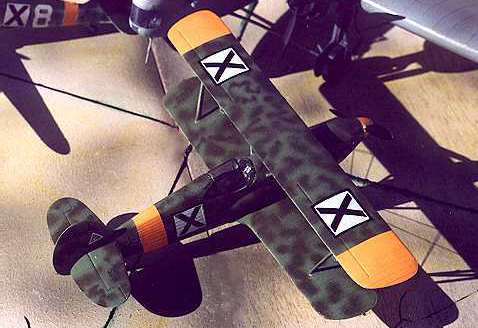 The kit
starts to build by detailing the cockpit in interior green, followed by
assembling other interior details that consist of seat, control column, rudder
pedals and an instrument panel. There is presence of flash, which is of a minor
nature and is easily trimmed away with a modeling knife, as the plastic is soft.
The canopy comes in clear plastic piece. This needed slight trimming to fit in
place.
The kit
starts to build by detailing the cockpit in interior green, followed by
assembling other interior details that consist of seat, control column, rudder
pedals and an instrument panel. There is presence of flash, which is of a minor
nature and is easily trimmed away with a modeling knife, as the plastic is soft.
The canopy comes in clear plastic piece. This needed slight trimming to fit in
place.
Like all KP kits the instruction sheet is very clear. These are in English and Czech language and contain exploded views showing parts emplacement. Other views show the decal and colour emplacement for the two options given. The instructions even indicates the angle of 24 degrees to the normal which dictates how forward the upper wing should be fixed ahead of the lower wing leading edge. Choice of wheels are provided, with or without spats mounted on the undercarriage. Apart from the good assembly instructions there is also detailed colour information to complete the model as a Czech version of a Slovak of uprising version. Most of this information is suited also to the Royal Bulgarian Air Force. With the wings set well on their struts it was the turn to drill tiny holes to take the rigging made from transparent thread. Alternatively one may use a thin gauge of fishing line. The end of the rigging was super glued and the upper surfaced sanded gently to hide the joining end.
| COLORS & MARKINGS |
Paintwork
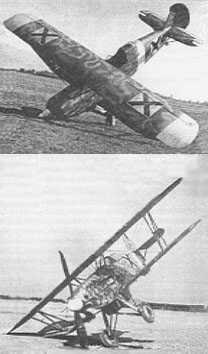 I selected an interesting
camouflage finish consisting of dark olive green mixed with few drops of yellow,
which altered the dark shade into a lighter one. All upper surfaces were
airbrushed in this shade. When dry a disruptive pattern of a much lighter
contrasting colour of green was carefully applied using the extra fine needle
supplied with the Badger double action airbrush. After allowing the paint to dry
for 24 hours, the upper camouflage was masked and the lower hellblu sky RLM spec
was applied. Any touches with upper camouflage green were carried out with a No
2 brush. The canopy was also carefully masked a
I selected an interesting
camouflage finish consisting of dark olive green mixed with few drops of yellow,
which altered the dark shade into a lighter one. All upper surfaces were
airbrushed in this shade. When dry a disruptive pattern of a much lighter
contrasting colour of green was carefully applied using the extra fine needle
supplied with the Badger double action airbrush. After allowing the paint to dry
for 24 hours, the upper camouflage was masked and the lower hellblu sky RLM spec
was applied. Any touches with upper camouflage green were carried out with a No
2 brush. The canopy was also carefully masked a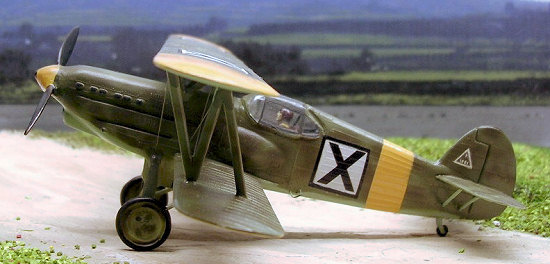 nd hand painted when in place.
Propeller and wheels were painted at a last stage. The kit was given an overall
coat of floor polish liquid, allowed to dry and the kit was now ready to receive
the Bulgarian AF decal markings.
nd hand painted when in place.
Propeller and wheels were painted at a last stage. The kit was given an overall
coat of floor polish liquid, allowed to dry and the kit was now ready to receive
the Bulgarian AF decal markings.
Decal markings
As for the ’X’ Bulgarian Air Force decals, these do not seem to be readily available although Blue Rider gave me reasons to believe that these were a possible future release. In the meantime other possible sources are Delta Decals sheet No 72-002 Luftwaffe Allies No 1 Bulgarian air Force. But in utilizing these decals one would spoil the chances of building the other Bulgarian Air Force aircraft such as a Do-17P, MB 200, Letov S328 and FW189 for which the correct size of decals are intended. Another source would be to use surplus BF-108 Taifun kit decals supplied by Heller. These are the correct size for the Avia but would have a black outline edge added depending on colour scheme selected for the B-534. The final option is to use Xtradecals sheet XPS-1 to obtain black stripes in combination with white squares cut to correct size from Micro scale white sheet TF-1 and which was incidentally the method I have used. The scale model was finally given a smooth coat of semi matt Revell varnish.
| CONCLUSIONS |
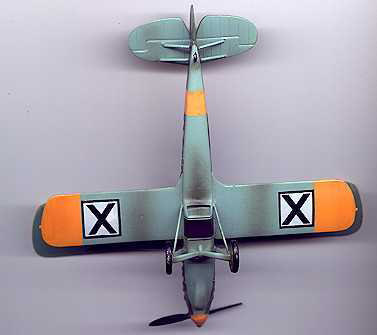 The Avia
B-534 is a biplane that was worthwhile kit to add to my collection of Bulgarian
Air Force section in view of its popularity and also with pilots who flew it in
various air forces that it served. One of these B-534s survived the war and is
accommodated at the Aviation Museum in Prague and is worth visiting if one
happens to be in the area. Overall this was an interesting subject completed in
not so common Bulgarian markings bringing a pleasing result at a very reasonable
price.
The Avia
B-534 is a biplane that was worthwhile kit to add to my collection of Bulgarian
Air Force section in view of its popularity and also with pilots who flew it in
various air forces that it served. One of these B-534s survived the war and is
accommodated at the Aviation Museum in Prague and is worth visiting if one
happens to be in the area. Overall this was an interesting subject completed in
not so common Bulgarian markings bringing a pleasing result at a very reasonable
price.
June 2007
Copyright ModelingMadness.com
If you would like your product reviewed fairly and fairly quickly, please contact the editor or see other details in the Note to Contributors.